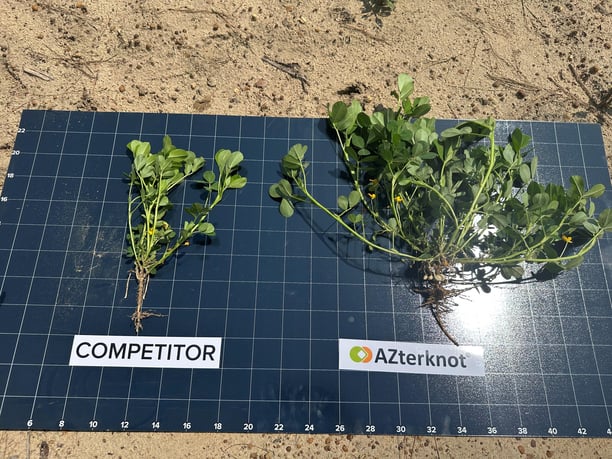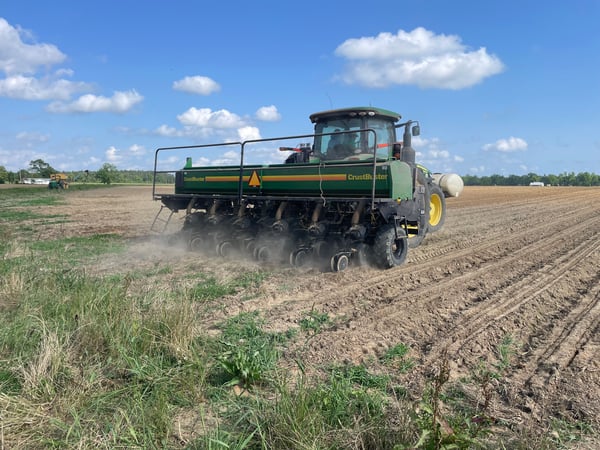By: George Huckabay, Southern Agronomist
May 25, 2023
You can always tell who a peanut farmer during planting season is because of the pink dust on their boots from peanut seeds. Planters have begun to roll across the peanut belt… the 2023 peanut season is here. Growers from Virginia down to the Florida panhandle over to Seminole, Texas, and up through Northeast Arkansas… everybody is running at a feverish pace to get this year’s crop in the ground.
From the 2,200 lbs. bulk sacks of peanut seed and the massive seed tenders to the smell of Thimet® and liquid bladders full of inoculant, the first time you experience peanut planting it is difficult to know what all goes into it. A peanut crop is a high-input crop and requires multiple fungicide, insecticide, and herbicide applications. Peanuts are bred using conventional breeding methods and are not GMOs. Most land grant universities in the peanut belt and some USDA facilities have bred nearly all the varieties of peanuts that have been released through the years.

The top peanut producers know that starting with good quality seed is a must. One of the hardest-to-control diseases is Aspergillus crown rot. It is thought to be directly caused by poor quality seed and tight crop rotation intervals. Several in-furrow fungicides had acceptable control of this disease, but reliance on these has caused the increase of incidence fungal pathogen resistance. This sparked ag chemical manufacturers to develop new fungicides and multiple modes of action seed treatments. Learning from the past, growers currently utilize a multifaceted approach including crop rotation, high-quality seed, multiple MOA seed treatments, and in-furrow fungicides.
Once a good stand is established the grower is in constant battle with weeds, insects, and diseases. Fungal diseases can be the most damaging and hard to control of the three pests. The diseases are divided into two categories: leaf spots and soilborne diseases.
One of the most destructive soilborne diseases is white mold, Schlertoinia rolfsii. White mold incidence increases over time with limited crop rotation and continuous peanut growing, can greatly increase yield loss, and tends to occur in the hottest part of the summer and can be more severe in dryer years. Getting fungicides through the peanut canopy and into the soil profile where the fungal mycelium is growing can be the hardest task for the grower. This has inspired some nonconventional approaches such as night spraying, using soil surfactants to help to penetrate the soil profile, and applying fungicides before the disease is active to try and hinder disease development. These have all had limited success and the grower relies on crop rotation and the most highly active AI’s for white mold on the market.

Peanut leaf spot diseases are broken down into early leaf spot and late leaf spot by when they typically occur in the lifecycle of the peanut. Like soilborne diseases, their incidence increases with poor crop rotation too. A program approach is utilized to combat these diseases and in the higher disease pressure areas of the southeast, leaf spot fungicides are applied every 14 days starting 45-60 days after planting. Once the grower reaches the disease threshold these applications begin.
Protectant-type fungicides like chlorothalonil have been the top choice for many years. But recently growers have been substituting AZterknot®, a chemical + bio stimulant fungicide. The biostimulant consists of the extract from the knotweed plant Reynoutria sachalensis (RSE). RSE is known to help plants increase their internal defense mechanisms through induced acquired resistance. It strengthens the cell walls and decreases pathogen penetration into plants.
AZterknot is recommended to be applied in your 1st or 2nd application with the addition of a DMI fungicide to increase the control spectrum. Applying AZterknot early will help to ensure that your peanut crop is off to a strong start.
Important: Always read and follow label directions. Thimet 20-G® is a trademark of AMVAC. AZterknot® is a registered trademark of Vive Crop Protection. ©2023 Vive Crop Protection Inc.
